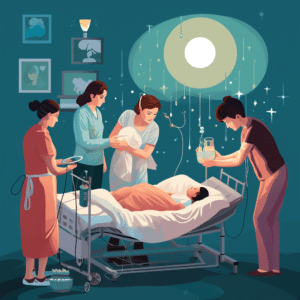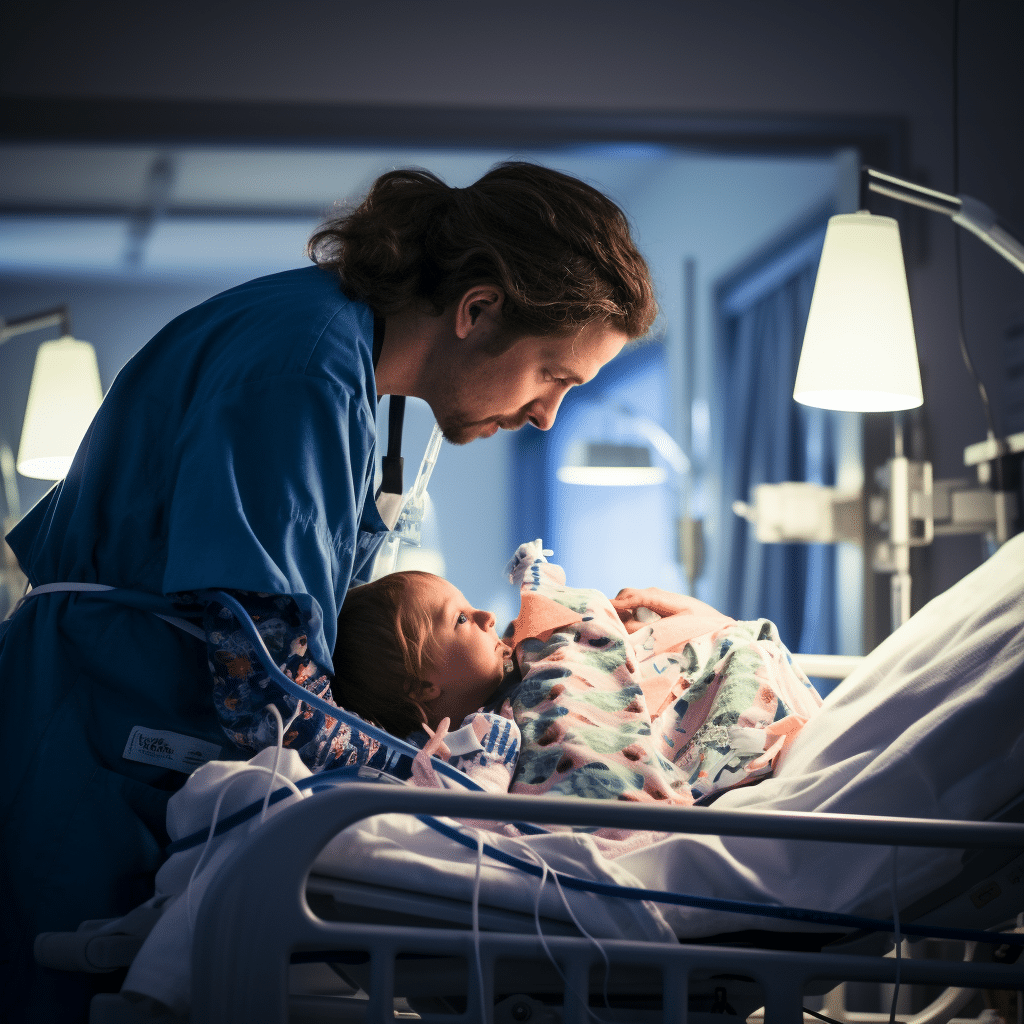Exploring Childbirth: Types, Risks and Choices
Exploring Childbirth: Types Risks and Choices: To gain a comprehensive understanding of the risks associated with different types of childbirth, delve into the introduction. Explore the intricacies of childbirth and its significance, as it sets the stage for the subsequent discussions on the various childbirth methods and their respective risks.

Explanation of childbirth and its importance
Childbirth is an incredible process. A baby is born from the mother’s womb, marking new life and a special bond between mother and child. Physiological changes, hormonal adjustments, and emotional bonding all contribute to the newborn’s well-being.
The mother’s body goes through many stages. Contractions start it off, and the push at the end brings the baby into the world. It’s not only about the journey, but the impact on maternal health and bonding with the child.
This event has cultural and societal importance. It symbolizes hope, continuity, and life. Rituals and traditions celebrate the miracle. It’s a connection between generations, bridging past, present, and future.
The Embera Chami tribespeople in Colombia show the power of a woman during childbirth. They practice traditional, home births without medical intervention or pain relief. They use their inner strength and wisdom to bring their babies into the world.
Childbirth is awe-inspiring. It symbolizes human strength and perseverance, and celebrates diversity across cultures. Let us honor and respect this journey, bringing new life into our world.
Different Types of Childbirth
To understand the different types of childbirth and the associated risks, explore vaginal birth, cesarean section, assisted vaginal delivery, and home birth. Each approach carries its own set of advantages and considerations, providing diverse options for expectant mothers. Delve into the details of these childbirth methods to make informed Exploring Childbirth: Types Risks and Choices decisions about the best approach for you and your baby.
Vaginal Birth
Vaginal birth has many advantages for both mothers and babies. It brings faster recovery for moms and reduces complications, plus promotes bonding with the newborn and breastfeeding. Babies benefit too; passing through the birth canal helps expel fluid from their lungs and strengthens their immune system.
Vaginal birth comes in different forms. Spontaneous vaginal birth is natural, without medical help. Induced vaginal birth uses meds or other methods to start labor. Assisted vaginal birth uses forceps or vacuum extraction to aid delivery.
Research shows vaginal births have lower maternal mortality rates than cesareans. A study in The Journal of Perinatal Education shows a lower risk of infection and blood loss during childbirth.
Risks associated with vaginal birth
Vaginal birth is natural, but it has risks. These include tears in the vaginal tissue, bleeding due to stretched vessels, and infection. Shoulder dystocia may occur where the baby’s shoulders get stuck behind the mother’s pelvic bone. This can lead to nerve damage, fractures, as well as prolonged labor and postpartum hemorrhage. These risks should not discourage individuals from choosing vaginal birth.
Healthcare professionals have a big role to play. With prenatal care, regular check-ups, and timely interventions, risks can be minimized. Communication with Exploring Childbirth: Types Risks and Choices your healthcare provider is key for making informed decisions and ensuring safety.
Common complications during vaginal birth
Common complications during vaginal birth can be caused by a number of factors. These challenges may include:
- Prolonged labor: When the active phase of labor goes longer than 20 hours for first-time moms or 14 hours for women who have already given birth. This may lead to exhaustion and increases the chance of infection.
- Fetal distress: Also known as nonreassuring fetal status. This is when the baby doesn’t get enough oxygen during labor, due to umbilical cord compression or placental insufficiency.
- Perineal tears: It’s typical for the perineum (between the vagina and anus) to tear or need an episiotomy. Severe tears can cause long-term issues, if not repaired correctly.
To counter these complications, it’s important to have skilled medical intervention. Also, expectant mothers and their partners should know that childbirth doesn’t always go as planned. Knowing possible complications and communicating with healthcare Exploring Childbirth: Types Risks and Choices providers can help reduce stress and make educated decisions throughout the birthing process.
Cesarean Section
To gain a clear understanding of Cesarean Section, let’s take a look at some key details. It is a surgical delivery of the baby, and either general or regional anesthesia is used. The incision is either vertical or horizontal (bikini cut). The recovery time is longer than vaginal birth, and there are risks such as infection, bleeding, and injury to organs. However, there are also advantages like reducing the risk of certain complications.
Also, it is important to note that Cesarean Sections may be performed in emergency situations. This is done to ensure the safety of both the mother and the child. Yet, it should only be done when other solutions have been attempted.
Surprisingly, the history of Cesarean Section dates back centuries. Historical records show that it has been done since ancient times. Initially, this was done as a life-saving measure for women suffering during labor. Over time, developments in Exploring Childbirth: Types Risks and Choices medical science and technology have improved the success rate and safety of Cesarean Sections.
Risks associated with cesarean section
Cesarean section, also known as C-section, is a surgical delivery done through an incision in the mother’s abdomen and uterus. Though life-saving in some situations, it carries potential risks. They include:
- Infection: At the incision site, uterus and surrounding tissues.
- Blood loss: Higher than vaginal delivery, leading to anemia or need for transfusions.
- Anesthesia reactions: Mild to severe.
- Slow recovery: Pain, discomfort, limited mobility during healing.
- Future pregnancy risks: Placenta previa & uterine rupture.
Every woman’s experience is unique. Factors like health, past surgeries, and circumstances can influence risks. Sarah* had an emergency C-section due to fetal distress. Both mother and baby made a full recovery, though Sarah needed more support during postpartum. It’s important for healthcare providers to discuss risks and benefits with patients, ensuring safety.
(*Name changed for privacy)
Reasons for choosing a cesarean section
Making the choice of a C-section, otherwise known as a cesarean section, can be motivated by various reasons. For instance, medical necessity, negative past experience, elective choice or health conditions. It’s important to chat with Exploring Childbirth: Types Risks and Choices healthcare providers about the risks and benefits.
Also, gentle C-section experiences are possible. This approach offers skin-to-skin contact, breastfeeding soon after birth and a family-centered atmosphere during surgery.
Sarah, one mother, chose a C-section after her last childbirth resulted in severe tearing. She wanted an emotionally positive birthing experience with less physical trauma. After detailed conversations with her medical team, Sarah was able to have a planned C-section feeling empowered and involved in her birth plan.
Every woman’s childbirth journey is unique. Exploring all available options with medical professionals is key to ensure the best outcome for the mother and baby.
Assisted Vaginal Delivery
Forceps or vacuum extractors can be used to help with delivery.
This is done when there are worries about the baby’s health or if labor isn’t advancing.
Assisted Vaginal Delivery usually occurs in a hospital, with necessary resources and know-how.
Pain relief can be administered, such as epidurals, to help with any discomfort the mom-to-be feels.
A decision is made on Assisted Vaginal Delivery based on risks and benefits, looking at both mom and baby factors.
It’s essential to talk with healthcare providers regarding birth wishes and worries.
Susan needed Assisted Vaginal Delivery because of long labor. With the help of her medical team and partner, she had a healthy baby girl. This highlights the importance of professional care during childbirth.
Risks associated with assisted vaginal delivery
Assisted vaginal delivery requires the use of medical instruments. It can be beneficial, yet carries risks. Injury to both mother and baby is a potential danger; forceps or a vacuum extractor can cause bruising, lacerations, and even fractures. Infection is also a risk as instruments introduce bacteria into the birth canal. Plus, the baby’s health could be affected with complications like facial nerve palsy, fetal distress, and oxygen deprivation.
You should only select this method if necessary and with the assistance of healthcare professionals. Have an in-depth discussion with your provider to ensure you are fully aware of risks and can make a sound decision.
Home Birth
A home birth is when a baby is born at home instead of in a hospital or birthing center. It creates a cozier, more intimate atmosphere for mom and baby. Midwives or doulas usually attend home births to provide individualized care during the pregnancy and delivery. They supply help, counsel, and assistance to make sure mother and child have a safe and positive experience. Plus, home births cost less than hospital births! Remember to do your research and find an experienced midwife or doula if you plan to have a home birth.
Risks associated with home birth
Giving birth at home can be seen as an alternate way of delivering a baby. But, it holds its own set of dangers that should be thought through. Here are some of the risks linked with home birth:
- Complications: In an unexpected situation where too much blood is lost or if there is high blood pressure, medical help may not be close.
- Monitoring: In contrast to hospitals that have the capacity to monitor the mother and the baby’s vital signs constantly, home birth may not have the same access to advanced medical stuff and healthcare experts.
- Delayed Intervention: In extreme cases needing emergency attention, time is key. Delayed access to medical services can greatly affect the mother and the baby’s outcome.
- Pain Relief: Though some women go for natural childbirth without medication, others may prefer pain control options like epidurals or other drugs. These options may be absent at home births.
It is also important to bear in mind that tests and screenings done in hospitals before delivery may not be possible at home births. Pregnant mothers who consider home birth should talk to their healthcare provider carefully about the potential risks and make a thorough plan for emergencies.
To reduce these dangers:
- Choose a knowledgeable healthcare provider who has done home births before: Make sure your midwife or doula is well-experienced in tackling any issues that might arise during home childbirth.
- Prepare for emergencies: Before delivery, plan a clear emergency plan with your healthcare provider. This includes talking about the nearest hospitals with maternity services and organizing quick transportation if needed.
- Get necessary supplies: Get all the recommended supplies by your healthcare provider in advance. This includes sterile equipment, medication, and tools that might be needed during labor.
- Stay in contact: Speak to your healthcare provider before, during, and after the home birth. This ensures that any changes in your health can be taken care of right away.
By taking into account these tips and being ready, expectant mothers can minimize the risks of home birth while getting a more intimate childbirth experience.
Advantages and disadvantages of home birth
Homebirth has pros and cons worth looking into. Let’s explore them! Check the table below for a detailed overview of home birth’s advantages and drawbacks:
| Advantages | Disadvantages |
| 1. Familiar atmosphere | 1. Limited medical help |
| 2. Increased comfort & control | 2. Possible complications not addressed right away |
| 3. Lower risk of infection | 3. Emergency response may be delayed |
| 4. Fewer unnecessary procedures | 4. Higher risk for first-time moms or high-risk pregnancies |
| 5. Care from known healthcare provider | 5. Emotional strain on family members present |
Also, midwives usually attend home births. They are professionals at handling low-risk pregnancies and natural childbirths.
Pro Tip: Before deciding on home birth, talk to a healthcare provider. They will assess if it’s the right choice for you, based on your health history and pregnancy.
Risks of Different Types of Childbirth
To better understand the risks associated with different types of childbirth, delve into the section on risks of different types of childbirth. Explore the sub-sections on maternal risks and fetal risks, providing insight into the potential dangers and complications that both the mother and baby may encounter during childbirth.
Maternal risks
It is vital for medical staff to be watchful of mothers during childbirth. Plus, expecting mums must get good prenatal care to reduce any complications.
Emily, a woman, had a tale to tell that showed the importance of being aware of maternal risks. She experienced extreme preeclampsia in her third trimester. This necessitated an urgent cesarean section. It was tough for her, however, with the help of expert medical staff, she gave birth to a healthy baby boy.
Emily’s story proves the strength of women who have to face maternal risks and highlights the need for great healthcare during pregnancy.
Physical risks for the mother during childbirth
Childbirth is an exhausting process with potential risks for the mother. Women can face various physical difficulties, such as tears in the perineum, excessive bleeding, and injury to internal organs like the bladder or uterus.
Every woman’s experience is different. Age, health, and past pregnancies can affect the likelihood of these dangers.
In addition, there are lesser-known risks. Prolonged labor increases the chance of infection and tissue damage. So it is important to monitor labor closely to avoid complications.
A Journal of Obstetrics and Gynecology study found that around 3% of mothers have serious childbirth complications. These include severe bleeding and infections that need medical help. These figures show the serious danger of childbirth.
Emotional risks for the mother during childbirth
Childbirth is an emotion-filled experience for mums. It can come with risks which affect their emotional health. These risks vary, depending on the person and the situation.
Anxiety is one such emotional risk. Many mums have high levels of anxiety before and during labor. This can come from worries about the baby’s health, fears about the delivery, or general unease about the unknown. Healthcare workers should address these fears and give support to help mums through this hard time.
Postpartum depression is another emotional risk. This happens after giving birth and involves feeling down, tired, and not wanting to do much. It can stop a mum from caring properly for herself and her baby. Healthcare workers should watch new mums carefully and offer help if needed.
Guilt is another possible risk. Mums can feel guilty if things don’t go as planned or if they think they have failed somehow. Healthcare workers should tell mums that these feelings are normal and give supportive counselling to help them with any guilt they feel.
It’s worth remembering that although these emotional risks are common, many women also find great joy in giving birth. Every birth experience is different, and it’s important to recognise both the difficulties and the rewards of bringing a new life into the world.
Sarah, a first-time mum, went into labor feeling excited but also nervous. She had heard stories from friends about tough births, adding to her anxiety. Thankfully, she had a supportive healthcare team who gave her reassurance throughout labor. After giving birth to a healthy baby girl, Sarah thanked them for the emotional support which made her birth experience positive.
Fetal risks
We’ve made a table to help you understand the types of fetal risks that can happen during childbirth. They are: premature birth, birth injuries, oxygen deprivation, umbilical cord problems, and infection.
It’s important to remember that each childbirth experience is different.
| Risk | Suggested Actions |
|---|---|
| Premature Birth | Have regular check-ups during pregnancy. |
| Birth Injuries | Learn about signs of labor distress. |
| Oxygen Deprivation | Choose an experienced healthcare provider. |
| Umbilical Cord Problems | Follow medical recommendations. |
| Infection | Follow medical recommendations. |
By doing these things, you can make the childbirth safer for both mother and baby.
Potential health risks for the baby during different types of childbirth
Potential health risks for babies during childbirth vary greatly. Here’s a peek at some of the common risks:
Vaginal Delivery:
- Risk of birth trauma from the birth canal.
- Baby’s skull shape may be temporarily altered, i.e. head molding.
- Shoulder dystocia, where baby’s shoulders get stuck.
Cesarean Section:
- Respiratory complications, such as rapid breathing or respiratory distress syndrome.
- Injury to mother during the procedure.
- Delays in breastfeeding and bonding due to post-surgery recovery.
Home Birth:
- Limited access to medical help in case of an emergency.
- Higher chances of infection with inadequate cleanliness protocols.
- Risk of neonatal seizures or brain damage from oxygen deprivation.
It’s important for expectant parents to discuss these Exploring Childbirth Types Risks and Choices risks with their healthcare provider. Every birth experience is unique, so not all risks may apply. Flexibility is key – having qualified professionals involved ensures the safety of both the mother and baby.
Nikita and James were excited for their home birth. However, Nikita experienced complications during labor. Their midwife acted quickly, transferring them to the hospital for an emergency cesarean delivery. This incident was a reminder that flexibility is crucial for childbirth planning. It also highlighted the importance of having qualified professionals involved.
Long-term effects on the baby based on the type of childbirth
The type of childbirth can have long-term effects on the baby. It’s vital to understand these risks for making informed decisions. Here is a table with the long-term effects based on different types of childbirth:
| Type of Childbirth | Long-Term Effects on Baby |
|---|---|
| Vaginal delivery | Respiratory issues and a stronger immune system |
| Cesarean section | Higher risk for allergies, asthma, and obesity |
Although vaginal delivery is safer for the baby, sometimes a cesarean section is necessary. Moreover, individual factors such as genetics and health can affect the long-term effects on the baby.
Pro Tip: Discuss your options with your healthcare provider. Consider your own preferences and any medical indications or complications that may arise during pregnancy.
Risk Factors and Considerations
To better navigate the risks associated with different types of childbirth, this section focuses on risk factors and considerations. Discover how factors that may increase the risks of various childbirth methods intersect with personal preferences and individual circumstances. Gain insight into making informed childbirth choices tailored to your unique situation.
Factors that may increase the risks of different types of childbirth
Childbirth is a natural and amazing event, but some factors can raise the risks. Expecting mothers and medical pros should think about these risk factors to guarantee a secure and healthy delivery.
- Age: Advanced maternal age, generally 35 or older, can increase the risks of problems during childbirth. Women may be more likely to have conditions such as gestational diabetes, high blood pressure, or placenta previa.
- Previous cesarean section: Women who had a prior cesarean section are more likely to have difficulties in subsequent pregnancies. These include uterine rupture, placenta accreta, and infection.
- Multiple pregnancies: Carrying more than one baby raises the risks associated with childbirth. Twins, triplets, or multiples of higher order may bring preterm labor, low birth weight, and other issues that need special care.
- Medical conditions: Medical conditions such as diabetes, hypertension, or heart disease can add to the childbirth risks. This needs additional monitoring and management to make sure of a safe delivery.
Moreover, special details like a history of premature birth or genetic predispositions can also affect the risks of childbirth. It is very important to consult health professionals and discuss personal medical history for understanding and managing these risks.
Pro Tip: Attend regular check-ups and follow prenatal care guidelines to stay informed about your health during pregnancy. Taking this proactive approach can help to identify any potential problems early and have a smoother childbirth.
Personal preferences and individual circumstances when considering childbirth options
When deciding on childbirth options, personal likes and conditions are crucial. Such considerations may include:
- Birthing Environment: Home or hospital? Access to medical interventions, midwives/doctors, and tech?
- Previous Birth Experiences: Positive or challenging?
- Support Systems: Who to include?
- Cultural Beliefs: Home-births or ancestral practices?
- Medical Considerations: Pre-existing conditions, high-risk pregnancies, etc.
Financial aspects must be taken into account too. Healthcare coverage and resources can influence choice. Consider these factors before making an informed decision. Take into account wishes and medical advice for a safe and satisfying experience. Make choices that align with your values. Explore options, talk to pros, and create a supportive system. Don’t let fear hinder you; trust your instincts and seize the chance to make a birth story that fits your personal preferences and individual circumstances.

Conclusion
To draw a conclusion about the risks of different types of childbirth, refer to our summary of associated risks. Prioritize discussing childbirth options with healthcare professionals to ensure informed decisions. Empower yourself with knowledge to make the best choices regarding childbirth.
Summary of the risks associated with different types of childbirth
Considering the risks of different types of childbirth is important. Take a look at these risks and their importance:
| Type of Childbirth | Risks |
|---|---|
| Vaginal Delivery | Perineal tears, infection, prolapse |
| C-section | Surgical complications, longer recovery |
| Home Birth | Limited medical interventions |
Vaginal delivery is natural, but can have risks such as tears, infections, and prolapse. C-sections have their own risks like surgical problems and a long recovery time. Home births may not have access to medical help if something goes wrong.
To reduce these risks, healthcare providers should educate expectant mothers on the possible complications. Prenatal care and monitoring during labor helps spot any issues. Cleanliness and proper hygiene also help reduce the risk of infection. Follow-up appointments after childbirth are also important to monitor the mother’s recovery and address any problems quickly.
Importance of discussing childbirth options with healthcare professionals
It’s essential to chat openly and thoroughly about childbirth options with healthcare pros. Such talks offer useful knowledge and direction, ensuring expectant parents make informed decisions regarding their delivery plan. Healthcare pros have a wealth of knowledge and experience, which enables them to answer any questions or worries that appear during the conversations.
A great part of talking about childbirth options with healthcare pros is the option to explore different circumstances and outcomes. They can give complete data on various birthing methods, such as natural birth, water birth, or cesarean section, outlining the pros and potential risks linked to each choice. This lets expectant parents carefully evaluate their options, taking into account their likes and medical situation.
Discussing childbirth options helps in better understanding
Exploring Childbirth: Types Risks and Choices Between healthcare pros and expectant parents. It creates trust and builds a collaborative relationship based on joint decision-making. By communicating desires and worries regarding the birthing process, healthcare pros can customize their recommendations accordingly, ensuring a more tailored and satisfactory experience.
Sarah, a decided mom-to-be, read up a lot before meeting her doctor to talk about her birthing preferences. Throughout the meeting, Sarah talked about her wish for an unmedicated water birth. Her doctor heard out her dreams while describing the available medical interventions if needed. Through their conversation, they formed a strong bond rooted in trust and mutual respect. Ultimately, Sarah’s doctor supported her during the labor process as she achieved her goal of bringing her baby into the world through a peaceful water birth.
Chatting openly about childbirth options with healthcare pros gives expectant parents with important guidance and certainty. These conversations let people make wise decisions that match their individual preferences and medical requirements. Sharing unique details makes sure that all aspects are taken into account before starting this transformative journey of parenthood.
Empowering individuals to make informed decisions about childbirth
Going on a crazy adventure! Wow! What a thought! Let’s get wild and explore the unknown.
Wild! Let’s embark on an adventure! Wow! What an idea! Let’s take the plunge and delve into the unknown. Let’s get crazy and discover something new!
Frequently Asked Questions
Question: What are the risks of vaginal childbirth?
Answer: While vaginal childbirth is considered the most natural method of delivery, it does come with some risks. These risks can include tearing of the vaginal tissue, pelvic organ prolapse, and urinary incontinence. However, most of these risks can be treated successfully.
Question: Are there risks associated with cesarean section (C-section) births?
Answer: Yes, there are risks associated with C-section births. Some common risks include infection, bleeding, blood clots, and injury to surrounding organs. C-sections also involve longer recovery periods compared to vaginal births.
Question: What are the risks of home births?
Answer: While some women opt for home births, it’s important to acknowledge the risks involved. These include a higher chance of complications such as neonatal asphyxia, postpartum hemorrhage, and infection. In case of emergencies, it may also take longer to access medical assistance.
Question: Are there risks associated with water births?
Answer: Water births can be a calming and comfortable option for some women. However, there are a few risks to consider, such as the baby inhaling water, infection from contaminated water, and the possibility of inadequate monitoring during labor.
Question: What are the risks of multiple births (twins, triplets, etc.)?
Answer: Multiple births carry higher risks Exploring Childbirth: Types Risks and Choices compared to singleton pregnancies. These risks include premature birth, low birth weight, preeclampsia, gestational diabetes, and a higher chance of birth defects. Multiple pregnancies typically necessitate specialist medical treatment and close monitoring throughout the whole pregnancy.
Question: Are there risks associated with assisted vaginal deliveries (forceps or vacuum extraction)?
Answer: Assisted vaginal deliveries can sometimes be necessary, but they do carry some risks. These risks can include vaginal or perineal tears, injuries to the baby’s scalp or face, and maternal pelvic floor muscle trauma. However, skilled obstetricians can minimize these risks.






